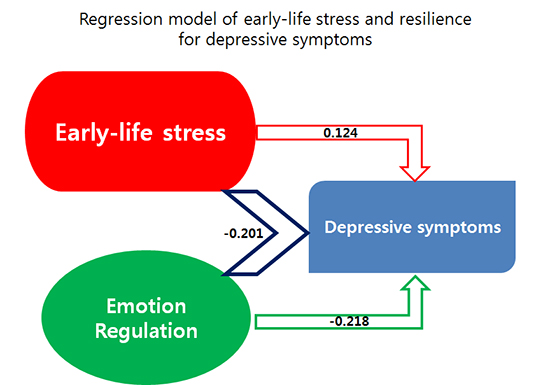1. Giedd JN, Lalonde FM, Celano MJ, White SL, Wallace GL, Lee NR, Lenroot RK. Anatomical brain magnetic resonance imaging of typically developing children and adolescents. J Am Acad Child Adolesc Psychiatry. 2009; 48:465–470.
2. Brown DW, Anda RF, Tiemeier H, Felitti VJ, Edwards VJ, Croft JB, Giles WH. Adverse childhood experiences and the risk of premature mortality. Am J Prev Med. 2009; 37:389–396.
3. Pechtel P, Pizzagalli DA. Effects of early life stress on cognitive and affective function: an integrated review of human literature. Psychopharmacology (Berl). 2011; 214:55–70.
4. Duggan C, Sham P, Minne C, Lee A, Murray R. Quality of parenting and vulnerability to depression: results from a family study. Psychol Med. 1998; 28:185–191.
5. Evans SE, Davies C, DiLillo D. Exposure to domestic violence: A meta-analysis of child and adolescent outcomes. Aggress Violent Behav. 2008; 13:131–140.
6. Roberts AL, Gilman SE, Fitzmaurice G, Decker MR, Koenen KC. Witness of intimate partner violence in childhood and perpetration of intimate partner violence in adulthood. Epidemiology. 2010; 21:809–818.
7. Kitzmann KM, Gaylord NK, Holt AR, Kenny ED. Child witnesses to domestic violence: a meta-analytic review. J Consult Clin Psychol. 2003; 71:339–352.
8. Seok JH, Lee KU, Kim W, Lee SH, Kang EH, Ham BJ, Yang JC, Chae JH. Impact of early-life stress and resilience on patients with major depressive disorder. Yonsei Med J. 2012; 53:1093–1098.
9. Sunday S, Kline M, Labruna V, Pelcovitz D, Salzinger S, Kaplan S. The role of adolescent physical abuse in adult intimate partner violence. J Interpers Violence. 2011; 26:3773–3789.
10. Rodriguez CM. Parent-child aggression: association with child abuse potential and parenting styles. Violence Vict. 2010; 25:728–741.
11. Hildyard KL, Wolfe DA. Child neglect: developmental issues and outcomes. Child Abuse Negl. 2002; 26:679–695.
12. Luthar SS, Brown PJ. Maximizing resilience through diverse levels of inquiry: Prevailing paradigms, possibilities, and priorities for the future. Dev Psychopathol. 2007; 19:931–955.
13. Werner EE. Vulnerable but invincible: high risk children from birth to adulthood. Eur Child Adolesc Psychiatry. 1996; 5:47–51.
14. Reivich K, Shatte A. The resilience factor: Seven essential skills for overcoming life's inevitable obstacles. New York: Broadway Books;2002.
15. Won HT, Han DW, Shin ES, Park KB, Lee YH, Yook SP. The final report on the development of Korea Military Personality Test. Seoul: Ministry of National Defense;1998.
16. Park DE, Yook SP. A study for screening effect and availability of the military personality test. J Korean Milit Med Assoc. 2004; 35:157–169.
17. Oh HJ. Effects of childhood abuse and exposure to parental violence on problem drinking in later life. Seoul, Korea: Yonsei University;2004. Dissertation.
18. Straus MA. Measuring intrafamily conflict and violence : the Conflict Tactics (CT) Scales. J Marriage Fam. 1979; 41:75–88.
19. Jang HJ. The development of a child abuse assessment scale. Seoul, Korea: Sookmyung Women's University;1998. Dissertation.
20. Kim JH. Resilience: pleasant secrets changing advesity into fortune. Koyang: Wisdomhouse;2011.
21. Perry BD. The neurodevelopmental impact of violence in childhood. In : Schetky D, Benedek EP, editors. Textbook of child and adolescent forensic psychiatry. Washington, DC: American Psychiatric Press;2001. p. 221–238.
22. Veenema AH. Early life stress, the development of aggression and neuroendocrine and neurobiological correlates: what can we learn from animal models? Front Neuroendocrinol. 2009; 30:497–518.
23. Straus MA, Savage SA. Neglectful behavior by parents in the life history of university students in 17 countries and its relation to violence against dating partners. Child Maltreat. 2005; 10:124–135.
24. Wolfe DA, Crooks CV, Lee V, McIntyre-Smith A, Jaffe PG. The effects of children's exposure to domestic violence: a meta-analysis and critique. Clin Child Fam Psychol Rev. 2003; 6:171–187.
25. Charney DS. Psychobiological mechanisms of resilience and vulnerability: implications for successful adaptation to extreme stress. Am J Psychiatry. 2004; 161:195–216.
26. Eisenberg N, Sulik MJ. Emotion-related self-regulation in children. Teach Psychol. 2012; 39:77–83.
27. Curtis WJ, Cicchetti D. Emotion and resilience: a multilevel investigation of hemispheric electroencephalogram asymmetry and emotion regulation in maltreated and nonmaltreated children. Dev Psychopathol. 2007; 19:811–840.
28. Maughan A, Cicchetti D. Impact of child maltreatment and interadult violence on children's emotion regulation abilities and socioemotional adjustment. Child Dev. 2002; 73:1525–1542.
29. Southwick SM, Vythilingam M, Charney DS. The psychobiology of depression and resilience to stress: implications for prevention and treatment. Annu Rev Clin Psychol. 2005; 1:255–291.
30. Yehuda R, Flory JD, Southwick S, Charney DS. Developing an agenda for translational studies of resilience and vulnerability following trauma exposure. Ann N Y Acad Sci. 2006; 1071:379–396.
31. Wagner B, Knaevelsrud C, Maercker A. Post-traumatic growth and optimism as outcomes of an internet-based intervention for complicated grief. Cogn Behav Ther. 2007; 36:156–161.
32. Wille N, Bettge S, Ravens-Sieberer U. BELLA study group. Risk and protective factors for children's and adolescents' mental health: results of the BELLA study. Eur Child Adolesc Psychiatry. 2008; 17:133–147.
33. Gillham JE, Reivich KJ, Freres DR, Chaplin TM, Shatté AJ, Samuels B, Elkon AG, Litzinger S, Lascher M, Gallop R, et al. School-based prevention of depressive symptoms: A randomized controlled study of the effectiveness and specificity of the Penn Resiliency Program. J Consult Clin Psychol. 2007; 75:9–19.
34. Scott KM, Smith DR, Ellis PM. Prospectively ascertained child maltreatment and its association with DSM-IV mental disorders in young adults. Arch Gen Psychiatry. 2010; 67:712–719.
35. Scott KM, McLaughlin KA, Smith DA, Ellis PM. Childhood maltreatment and DSM-IV adult mental disorders: comparison of prospective and retrospective findings. Br J Psychiatry. 2012; 200:469–475.










 PDF
PDF ePub
ePub Citation
Citation Print
Print



 XML Download
XML Download